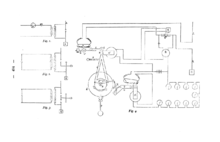Franz Morawetz
Franz Morawetz (* 1872 ; † December 27, 1924 ) was a Viennese watchmaker and inventor .
Life
Franz Morawetz was the subsequent owner of the watch shop run by Carl Morawetz from 1866 at Neubaugasse 28 in the 7th Neubau district of Vienna , which also supplied the aristocracy and the imperial court. For his competence he was appointed kuk court watchmaker and kuk sworn treasurer. From 1900 the head office was at Kohlmarkt 11 in the 1st district .
In addition to the sale of pocket, blind and smaller clocks, Morawetz was responsible for the manufacture of the technical equipment for the “ Ankeruhr ” on the Hohen Markt in 1913/14 . On September 22nd, 1914 he received the title of kuk chamber clockmaker from Emperor Franz Joseph I , which was an even higher honor than the court title.
There is still a watch shop in the former business premises on Kohlmarkt. The glass company board with the inscription "Kammer-Uhrmacherer His Majesty the Emperor u. King ”and the emperor's personal coat of arms is preserved above the entrance.
invention
Operation of electric clocks using electric waves
Franz Morawetz was a technical pioneer in the field of clocks. Together with Dr. Max Reithoffer invented and developed in 1905 a "device for operating electrical clocks using electrical waves". In the case of a signal sent by a central station at certain time intervals, the invention consisted in the fact that a drive was opened in the receiving station by this received signal, which then gradually returned to its original position, inhibited by a spring by a pendulum, and only then did the temporarily interrupted receiving circuit closed again to wait for the next pulse. Since the transmission time intervals were set to about 1 minute, the reception of every single minute transmission signal pulse would have been necessary for sufficient accuracy. The invention received a patent in Switzerland and at the Imperial Patent Office in Berlin .
Since the invention could not be implemented in practice, it was not marketed.
Web links
Individual evidence
- ↑ a b c Archive Clock Museum Vienna
- ↑ a b Entrance of Franz Morawetz's former shop on Vienna's Kohlmarkt
- ^ Watches for the blind, 1917
- ↑ Court State Handbook Austria 1917
- ↑ Electrical engineering. Innovations in electrical clocks . In: Theodor Koller (Hrsg.): Latest inventions and experiences in the fields of practical technology, electrical engineering, trade, industry, chemistry, the land and housekeeping . tape XXXIV , no. 11 . Vienna 1907, p. 452-456 .
- ↑ Swiss Patent No. 37912 of August 20, 1906
- ↑ German Patent No. 188 425 of September 17, 1907
| personal data | |
|---|---|
| SURNAME | Morawetz, Franz |
| BRIEF DESCRIPTION | Austrian watchmaker and inventor |
| DATE OF BIRTH | 1872 |
| DATE OF DEATH | December 27, 1924 |


